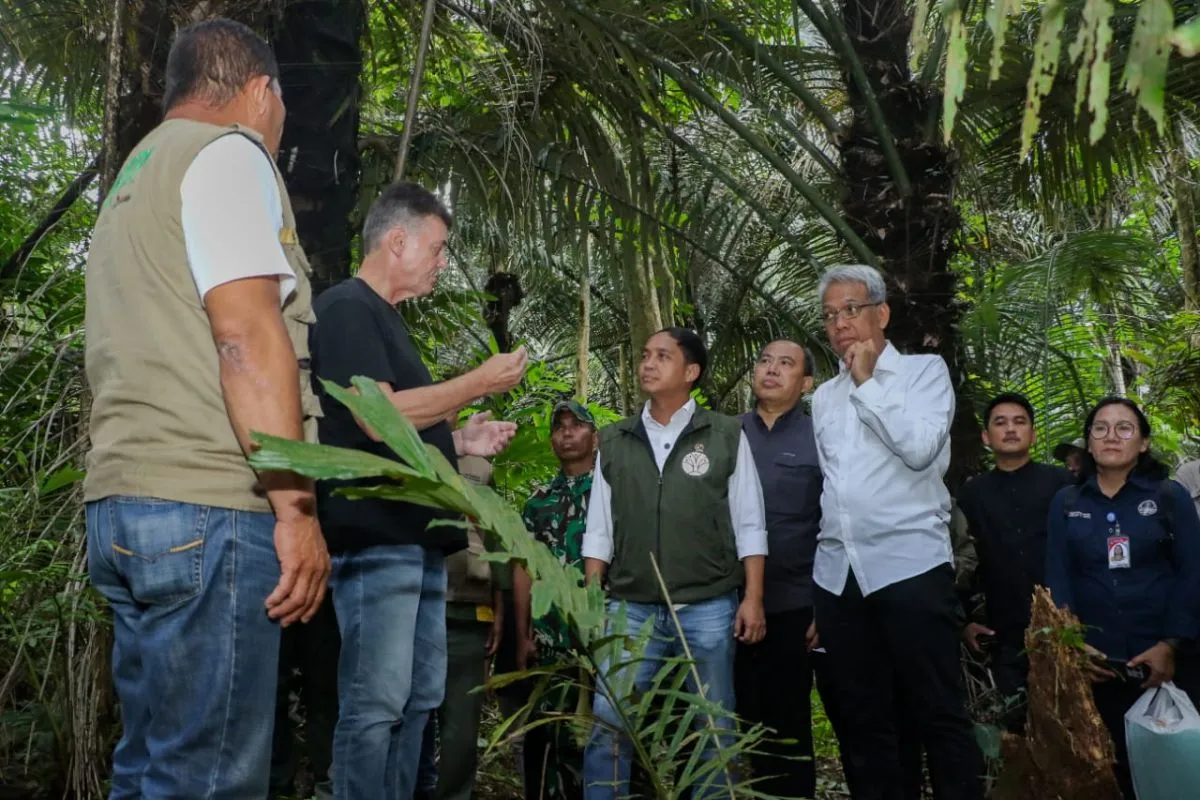Live Streaming
Program Highlight
Company Profile
Indonesia Today
VOI News, Jakarta: Acting Deputy for Tourism Products and Activity Organizers of the Indonesian Ministry of Tourism, Vincent Jemadu has explained that ...
VOI News, Jakarta: Indonesian Minister of Tourism Widiyanti Putri Wardhana is optimistic that the achievement of the tourism sector in 2024 will exceed the performan...
VOI News, Jakarta: Indonesian Minister of Tourism, Widiyanti Putri Wardhana has conveyed that the Christmas 2024 and New Year Holiday 202 is a big momen...
VOI News, Jakarta: Russian Ambassador to Indonesia, Sergei Gennadievich Tolchenov has said that bilateral cooperation between Indonesia and Russia is further strengt...
VOInews, Jakarta: Minister of Communication and Digital Affairs (Menkomdigi) Meutya Hafid emphasized that mothers play a crucial role in regulating children’s internet ...
The Australia-Indonesia BRIDGE school partnerships program, together with officials from the West Sumatra Education and Religious Affairs Offices in Padang, West Suma...
Discussion with the Ambassador of Canada to ASEAN, H.E. Vicky Singmin. From the Canadian Armed Forces (CAF), Colonel Scott Raesler and Lieutenant Colonel Melanie Lake as k...
Minister of Culture Fadli Zon speaks to reporters in Bandung, West Java, on December 14, 2024. (ANTARA/Ricky Prayoga) VOInews, Bandung : Minister of Culture Fa...
Secretary of the Directorate General of Culture of the Ministry of Culture, Fitra Arda, speaks during an event to promote the Ngawuwuh tradition in Garut, West Java, on De...
Minister of Culture Fadli Zon speaks to reporters in Bandung, West Java, on December 14, 2024. (ANTARA/Ricky Prayoga) VOInews, Bandung : Minister of Cultu...
Minister of Foreign Affairs Sugiono presents his remarks to open a public discussion on the 75th year of Indonesia-the United States relation in Jakarta on December 13, 20...
Forestry Minister Raja Juli Antoni visits the production of palm sugar at the Masarang Foundation, Tomohon, North Sulawesi, on Friday (December 13, 2024). (ANTARA/HO-Forestry...
Members of the Indonesian Navy, part of the TNI MTF Task Force Garuda Contingent XXVIII-P UNIFIL, participate in a farewell ceremony at Madura Pier, Surabaya, East Java, on Thu...
Social Affairs Minister Saifullah Yusuf held a meeting with the World Bank representatives in Jakarta on Thursday (Dec 12, 2024). (ANTARA/HO-Ministry of Social Affairs) - ...
Marubeni Corporation (“Marubeni”) has signed MOU with Impack Pratama Group through its subsidiary named PT Sirkular Karya Indonesia (“SKI”) on 6th December 2024 - ...
President Prabowo Subianto delivering a speech at the inauguration of the Tunnel of Friendship connecting Istiqlal Mosque and Jakarta Cathedral in Central Jakarta on Thurs...
VOInews, Jakarta: The United States has reaffirmed its commitment to supporting Indonesia in protecting orangutans through collaborative partnerships. This pledge was c...
VOInews, Jakarta: Qatar has reaffirmed its dedication to strengthening bilateral ties with Indonesia, focusing on enhanced trade and investment across diverse strategic...
A group photo of Japanese Deputy Ambassador to Indonesia Katsuro Nagai with representatives of Indonesian pesantren leaders during the welcoming ceremony for participants of th...
Minister of Tourism Teuku Riefky Harsya with the cast and producers of the film Women From Rote Island during the special documentary screening of the film Women From Rote Isla...
Indonesia Today
International News
International News
Featured Articles
Rice is the staple food of Indonesian people. No wonder, there are many various kinds of menus made of rice in Indonesia. The...
Proud news comes from the children of the nation. The Reactics Chem-E-Car team from Gadjah Mada University has made another great achie...
December
Photo credit: Indonesian Embassy in Sarajevo The Indonesian Embassy in Sarajevo once again participated in the Diplomatic Wi...
Photo credit: kompasiana Batujajar Bunker is a relic site found during the Dutch colonial era. It stands in a green ar...
Photo credit: Antara Indonesian traditional musical instrument angklung mesmerises visitors at the Chigasaki Cross Culture F...
EDITORIAL VOI
Death toll in West Sulawesi's earthquake has climbed to 56: BNPB
- Details
- Category: VOI
- Written by Wenny Zulianti
The death toll in West Sulawesi's 6.2-magnitude earthquake ensued by several aftershocks that rattled Majene and Mamuju Districts on early Friday has climbed to 56, according to Indonesia's National Disaster Mitigation Agency (BNPB).
Forty seven residents died in Mamaju District, and nine others died in Majene District owing to the strong earthquake, the agency's spokesperson, Raditya Jati, said in a statement that received on Sunday.
The earthquake, whose epicenter was located on land, six kilometers northeast of Majene District, at a depth of 10 kilometers, also caused 826 residents to get injured. Majority of the wounded victims were found in Majene, he said.
In Mamuju District, the BNPB recorded that 189 victims sustained serious injuries and were being hospitalized, Jati said, adding that the electricity supplies to several disaster zones had gradually been restored.
As part of emergency measures and mitigation efforts, the officials of disaster mitigation agencies in Majene, Mamuju, and Polewali Mandar Districts were registering locals badly suffering from the impact of the catastrophe.
They also set up temporary shelters for displaced residents, and coordinated mitigation efforts with those from related government agencies, police and military institutions, National Search and Rescue Agency (Basarnas), and volunteers.
The Majene-Mamuju road section has been restored after those from the 1401/Majene district military command's army engineering unit cleaned the highway by using backhoes.
As a result, normal traffic flow could have resumed since Saturday afternoon, he said.
On Saturday, the BNPB had also disbursed Rp4 billion in cash aid to the West Sulawesi provincial government and the district administrations of Mamuju and Majene.
In addition to that, the agency had also distributed relief aid packages to those in dire need, including eight tents for displaced people undergoing self-isolation, 10 tents for refugees, 2,004 nutritious food packs, and 30 power generators.
On the day the powerful earthquake rocked the districts of Majene and Mamuju, some two thousand locals to flee in pursuit of refuge at safer areas, Raditya Jati stated.
The shallow quake, which the Meteorology, Climatology, and Geophysics Agency (BMKG) believe was caused by local fault, also destroyed several buildings, including the governor's office, a military office, and Maleo Hotel.
The earthquake, which also damaged many houses and a public health center, additionally triggered three landslides along the Majene-Mamuju road section and disrupted the transportation of people and goods, Jati revealed.
Earthquakes regularly hit various parts of Indonesia since the country lies on the Circum-Pacific Belt, also known as the Ring of Fire, where several tectonic plates meet and cause frequent volcanic and seismic activities.
One of the deadliest earthquakes rattling eastern Indonesia occurred in several areas of Central Sulawesi Province on September 28, 2018.
The 7.4-magnitude earthquake followed by a tsunami that hit the areas of Palu City and the districts of Donggala, Paringi Moutong, and Sigi on Sept 28, 2018, claimed 2,102 lives, injured 4,612, and rendered 680 others missing.
A total of 68,451 homes were seriously damaged, while 78,994 people were displaced.
BUSINESS ADDRESS
Jl. Merdeka Barat, 4-5, 4th Floor,
Jakarta 10110.
Phone : +62 21 3456 811,
Fax : +62 21 3500 990
Shortwave : 3325 kHz, 4755 Khz


























/y4ycnfd8rd8czqa.jpeg)




























